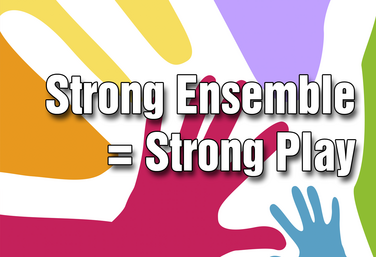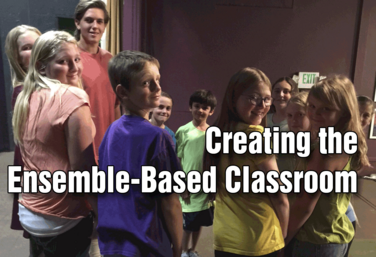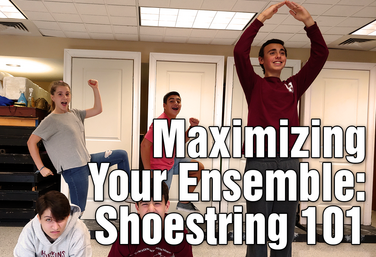Courses

PD COURSE
Strong Ensemble = Strong Play
by Craig Mason
This mini-course will give you a toolkit to bring your shows to the next level by having an engaged, active, ensemble.
The ensemble is a critical part of a large cast show. But you can't leave them to fend for themselves. They need structure. They need exercises and activities.
In Strong Ensemble = Strong Play, you'll be given ensemble-building exercises. You'll also discover specific activities that will help your ensemble become three-dimensional characters who have something to do and something to play in every moment they are on stage.
We'll look at case studies that take the exercises learned in the course and apply them to specific shows.
Read More
about Strong Ensemble = Strong Play
Read Less
about Strong Ensemble = Strong Play

PD COURSE
Creating the Ensemble-Based Classroom
by Gai Jones
Gai Jones will help you establish an ensemble-based environment from the first day of class or rehearsal.
Learn how to set up your ensemble-based classroom from day one, get students to set classroom norms, and find the balance between creative activity and structure. You’ll learn how to give your students creative freedom through structure and classroom management. The cornerstone of this course are the detailed ensemble experiences from large group to small group and even individual experiences.
This course culminates in a devising model that you can use with your students, and takes you through process, product, performance and an evaluation.
You too can create the ensemble-based classroom.
Read More
about Creating the Ensemble-Based Classroom
Read Less
about Creating the Ensemble-Based Classroom

PD COURSE
Maximizing Your Ensemble: Shoestring 101
by Michael Calderone
This seven-part series is designed to transform that gaggle of actors cluttering your backstage from cumbersome extras into nothing less than the very center of your production.
Instructor Michael Calderone leads this course, through games and exercises geared to maximize your ensemble for your next production. These lessons are based on the ensemble technique that he's been using for the last 30 years, called the shoestring method.
The ensemble has a responsibility to work as one, and no role is more important than another. Without each actor playing their part, the other actors cannot tell the story to the best of their abilities. So join Michael in learning more about this exciting, practical and dramatic method.
Read More
about Maximizing Your Ensemble: Shoestring 101
Read Less
about Maximizing Your Ensemble: Shoestring 101
Lesson Plans
LESSON PLAN
Building the Ensemble
by Lindsay Price
Use this lesson plan at the beginning of the year to introduce the concept of ensemble and what it means to work together.
Part One: Students participate and then reflect on exercises where they have to work together to make the exercise successful. They are given an Ensemble Expectations Handout.
Part Two: Students participate and then reflect on exercises where they have to work together as an ensemble in a theatrical context. Here the exercises add elements of character and story such as creating a family portrait, tableau, group objects, one word storytelling, and choral speaking.
Read More
about Building the Ensemble
Read Less
about Building the Ensemble
LESSON PLAN
Ensemble Community Building
by Dustin Loehr
To begin establishing an Ensemble by creating opportunities for students to:
1. Collaborate
2. Trust each other
Students will work together in small groups or in pairs to solve various challenges. Challenges involve using their non- verbal skills to communicate, working together through movement and support of weight and trust. Students will complete the following activities in this order:
1. Human Knott
2. Body to Body
3. Weight Sharing
4. Circle Trust
Read More
about Ensemble Community Building
Read Less
about Ensemble Community Building
LESSON PLAN
Flocking/Group Movement
by Karen Loftus
Birds flying in the sky appear as if they’re in perfect formation and synchronization. They’re aware of each other and the space around them at all times. Through this exercise, students will explore different types of movement and how it can express certain feelings and concepts. They’ll also build trust and ensemble by working together to create choral movement connected to vocal pieces.
Read More
about Flocking/Group Movement
Read Less
about Flocking/Group Movement
Resources
RESOURCE
Engaging Students to Work Together
This handout will help you answer the question: How can you get your students to engage with each other, work with each other and include everyone?
Read More
about Engaging Students to Work Together
Read Less
about Engaging Students to Work Together
RESOURCE
Ensemble Experiences: Large Group
Each ensemble experience includes the title, a list of objectives you can choose from, the goal, guidelines, and instructions.
Read More
about Ensemble Experiences: Large Group
Read Less
about Ensemble Experiences: Large Group
RESOURCE
Ensemble Experiences: Small Group
Each experience includes the title, a list of objectives you can choose from, the goal, guidelines, and instructions.
Read More
about Ensemble Experiences: Small Group
Read Less
about Ensemble Experiences: Small Group
RESOURCE
Distance Ensemble Experiences for Students and Educators
The experiences detailed here can be used during online sessions for Warm-ups, Collaboration, Cool Downs. Students experience the 21st Century Skills-Creative Thinking, Critical Thinking, Communication and Collaboration (by distance).
Read More
about Distance Ensemble Experiences for Students and Educators
Read Less
about Distance Ensemble Experiences for Students and Educators
Attachments

RESOURCE
02 - Distance Ensemble Experiences - Gai Jones
Gai Jones leads this session on Distance Ensemble Experiences with ideas you can use for both students and educators.
Read More
about 02 - Distance Ensemble Experiences - Gai Jones
Read Less
about 02 - Distance Ensemble Experiences - Gai Jones
Attachments
RESOURCE
1 - Expectations & Ensemble Building
A common unit to start the year has teachers and students setting classroom expectations, identifying procedures and at the same time establishing community through ensemble-building exercises. The two concepts go hand-in-hand if you want a smooth running classroom. This also makes it the perfect unit to introduce inclusivity. This section includes suggestions for discussions around respect with regard to classroom expectations, and ensemble building exercises with a focus on “Who am I?” and “Who are We?” This section also includes a document on creating an Anti-Slur Policy.
Read More
about 1 - Expectations & Ensemble Building
Read Less
about 1 - Expectations & Ensemble Building
Attachments